What is a polarizing filter? Polarizing filters
Today, photographers have a whole arsenal of tools at their disposal - modern digital cameras, lenses, additional equipment and, of course, filters. They are different and are used depending on the specific situation and task that the photographer sets for himself.
Deserves special attention polarizing filter for lens. Everyone has one good specialist. Install it on the lens on a sunny day to eliminate glare from non-metallic surfaces.
Polisher in bad weather?
Left, right without polarizing filter. Notice the water, sky, and colors of the landscape. Comparison: Without and with a polarizing filter. Blue sky and golden yellow autumn leaves. Depending on the motive, a polarizing filter is also suitable for use in bad weather. Its ability to dampen non-metallic reflections makes it invaluable when recording water. Long exposures to daylight and a polarizing filter eliminated water levels and produced rich colors.
Simply put, polarizing filters are a type of reflective filter. for the camera. Linear filters are now almost never used because they are simple. Autofocus and exposure measurement results. may falsify. That's why we dedicate ourselves exclusively to technology and technology. use of circular polarizing filters.
Colors become more saturated, the brightness of the sky blue is smoothed out. It is also possible to get rid of haze when photographing objects from a distance and from the glare of glass and water when photographing bodies of water. The position of the filter can be adjusted to obtain the desired shades in the photo that cannot be achieved through processing.
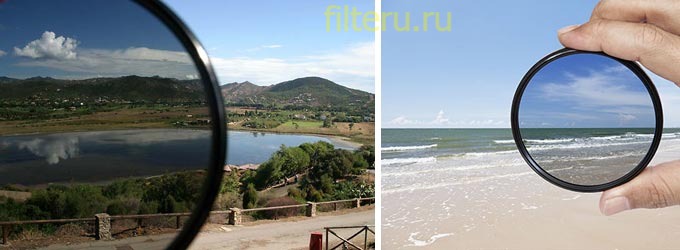
Unfortunately, this does not work on metal surfaces. When the filter is installed correctly, there are no window panels. For example, in a pond you can use reflections. sun on the surface of the water and photograph it. For example, animals such as fish or frogs underwater from the outside.
In the case of plant photography, the use of polarizing filters results in a green reproduction. A polarizing filter suppresses disturbing blue sky reflections. The polarizing filter screws directly to the front of the lens. Adjustment is made by turning the two polarizing filter rings in opposite directions. Therefore, unfortunately, you cannot use lenses with which the filter. when focusing.
All manufacturers offer seemingly identical filters, but different prices. The cheapest ones are a glass filter in a thick frame.
More expensive models have thin frames, which eliminate vignetting when used on wide-angle equipment. Experts recommend not saving on this device and advise purchasing a high-quality product that will last a long time.
A polarizing filter also works well when photographing skies and clouds. It saves most bright light, and the sky appears this way. In photographs, more energetic clouds also appear more flexible. Since the polarization effect always depends on the angle to the Sun, an extreme occurs. A wide-angle lens has an undesirable effect on the sky on one side. almost black in the picture and blue on the other side. For this reason, polar filter insertion is only recommended for wide-angle recording.
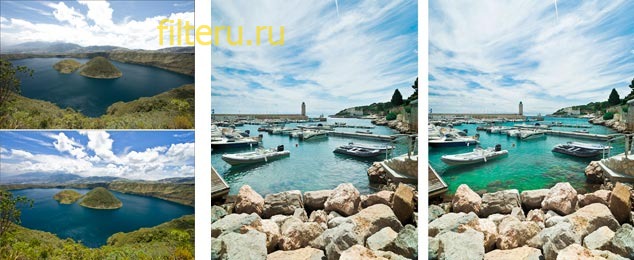 Working with or without a polarizing filter
Working with or without a polarizing filter Using a polarizing filter allows you to block or transform polarized light that is reflected from shiny surfaces. To do this, a film is placed between two glass lenses. By turning the top ring of the filter, you can adjust the degree to which the polarization of light is blocked.
A big effect when you want to photograph a rainbow is a polar filter. Colors are completely suppressed at a certain filter position and. are not shown in the photo. In the opposite position. but the colors are much stronger than the random polarization of the clouds. More than half was “swallowed”.
In the case of metal surfaces, a polarizing filter is unlikely to provide a remedy for reflections. This is why it is often used in conjunction with flash. in the so-called transverse flare. Also, the price class ranges from 1 to 150 euros. I also have a good polarizing filter from Hong Kong. Polarization: Light is made up of electromagnetic waves that vibrate at right angles. Polarizers are capable of generating electromagnetic waves that are generated from a specific. Guide them.
According to the effect they have on the image, filters are divided into:
- general purpose
- changing color,
- combined with other filters,
- enhancers of specific colors.
General purpose polarizing filters are classified into two categories - linear and circular polarizing filters (also known as circular).
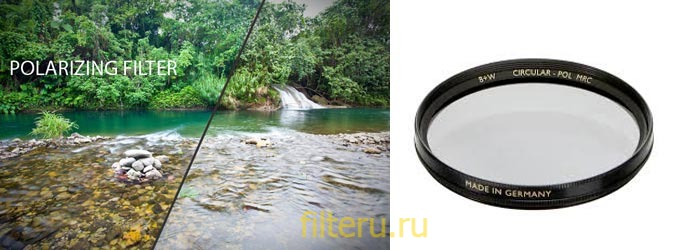
Polarizing filters in the field of photography consist of two glass surfaces that contain a polarizing filter film. The molecules on this absorbent film are aligned in parallel. and completely filter the light in a certain direction.
If you already have a DSLR camera, one of the first accessories you can add to your gloves is a photographic filter. There are many photography filters, but there are perhaps three that every photographer should have on their team. Let's see which ones are the most important and what they serve.
With the advent of digital, linear models practically disappeared from the market, however, the effect of their use is no worse than that of circular ones.
For digital cameras equipped with an autofocus function, the use of circular polarizing filters is recommended. It consists of two frames that rotate relative to each other to achieve the desired effect.
This is the first filter you should take the glove with when you buy a target, especially if we are faced with a target that is not exactly cheap. Keep in mind that there is no need to skimp on the price since this is a glass that we put in front of the lenses and don't want it to detract from the quality of the whole.
For this reason it is also commonly called protective filter, as it is often used simply to protect the lens from possible falls or impacts from the lens. There are people who don't like to put a filter in front of a good lens or only use it in certain conditions, because if it is not a good filter, it can subtract the minimum sharpness in the photo, barely noticeable but sometimes there.
VIDEO REVIEW
- do not use on ultra-wide-angle lenses, as it will be difficult to achieve uniform polarization,
- the subject of shooting should be at right angles to the photographer, this will allow you to get the maximum effect; if the sun is behind or in front, the result of using the filter will be minimal,
- there will be no effect in diffuse lighting, for example, on a cloudy day,
- installing this type of filter on top of another can give a vignetting effect, reduce light transmission,
- Shooting through glass, such as a window, can give unpredictable results.
What to look for when buying - which polarizing filters are better
High-quality filters are not cheap. Thus, experts do not recommend spending money on devices costing less than one and a half thousand rubles.
The second filter you need to look for is a polarizing filter. A polarizing filter consists of two polarized crystals that can rotate one against the other. With a polarizing filter we will mainly be achieving two things. Eliminate unwanted reflections on reflective surfaces such as water or glass, allowing us to see what's standing. Ideal for photographing a window or shallow river, for example, where we want to show the background without getting reflections. Enhance the contrast of certain colors such as green and blue, revealing breathtaking skies with high contrast against the white clouds. Ideal for landscape photography. . Exist different levels depending on the amount they carry and are used to reduce the light hitting the target.
Moreover, if you use different lenses, another problem arises - either buy a filter for each of them, or use an adapter. The easiest way out of the situation is to decide on the object you most frequently use and buy a device only for it.
To get started, select the right type devices - linear or circular. The second is required for digital cameras with autofocus.
They are very useful when we need to shoot with low shutter speeds and wide apertures, but we have a lot of light in the scene. The main advantage is that they leave aperture stops without affecting depth of field. Another reason to use a polarizing filter in nature photography is to reduce haze in images, which is common among landscape photographers. This problem can be reduced in post-processing by using special tools that solve the problem and add contrast to the image.
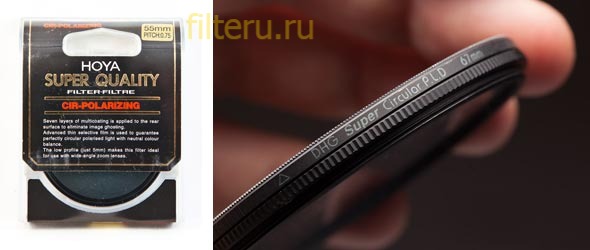
It is important to pay attention to the materials from which the device is made. Look through it at the sky or your computer screen. Cheap devices will give interference in the form of a cloudy picture, an odd image. This will especially affect the quality of the photo when shooting with a camera with a high-quality matrix.
However, when the fog is particularly severe, it is more difficult to eliminate afterwards; in any case, if we use a polarizer in the socket, there will always be additional help. Additionally, as stated in the previous section, using a polarizer will allow us to increase color saturation by eliminating reflections of objects that appear in the scene. Finally, using a filter helps make the sky look richer and darker, which is very difficult to achieve in post-production and brings life to the photo.
Unfortunately, not everything will be fine, and polarizing filters also have some disadvantages and problems, and they are few and far between. The first one has already mentioned its use during the hours of sunrise and sunset, where it can be used to make the sky appear unequal and therefore unreal. On the other hand, although its use is simple, as we have commented, using a polarizing filter requires less attention and time when shooting. Turning it one way or the other can change the result significantly, so you should use it "slowly".
Ask the seller for several models and take identical shots to compare the results at maximum magnification.

For the good ones SLR cameras devices are selected according to diameter, it is indicated by the manufacturer on the packaging and on the device itself.
Of course, the main disadvantage of circular polarizing filters is what we already talked about: that we steal light. That is, they reduce the amount of light entering the sensor, usually between two and three steps. This significant amount light, which can cause us problems, so best advice- use them only when they are needed.
On the other hand, using a polarizing filter may cause ghosting to appear in images. It is not in vain that we do not put another lens in front of the lens, and this can always be the cause of this kind of problem, especially if we use low quality filters. So even if they are expensive, think about not ruining the quality good lens with a cheap filter. Of course, it is also important to take care to clean both the front lens and the polarizing filter, since dust particles, etc. may become an additional problem when using a filter.
Based on manufacturers, filters can be roughly divided into the following categories:
- leaders: B+W Nano, Marumi Super DHG, Hoya Super HMC,
- average quality: B+W Pro, Marumi DHG, Hoya HMC,
- waterproof: B+W, Hoya HD, Marumi WPC CPL,
- standard - as a rule, all are of low quality.

Another problem is that the polarizing filter creates vignetting in the image, mainly used with angled lenses and with relatively thick filters. Because polarizers require a two-ring rotating design, it is common for these filters to be thicker than others. That aside, you should remember that it is convenient not to put too many filters at once. The last drawback is expensive filters. Of course, this depends on the size and quality of the filter, but certainly one quality can be quite expensive, and if you need to buy several for different purposes, the bill can be taken off.
Average quality devices with more affordable price can retain almost all the properties of favorites. In particular, it is worth noting the products of Marumi. With high quality, their price remains quite affordable. However, they do not offer innovative solutions, but simply make good filters for regular use.
For these cases, instead of purchasing several, it is recommended to buy a filter for the larger purpose we have and reuse it with other purposes based on filter adapter rings, a valid solution and much more affordable. Are you clear why a circular polarizer is an important tool in a photographer's bag? In the chemical age its use was very common, but in the digital age it seems to have been reduced by the idea that "everything can be improved a posteriori." However, its utilities are many, and some of them are almost impossible to obtain in post-processing.
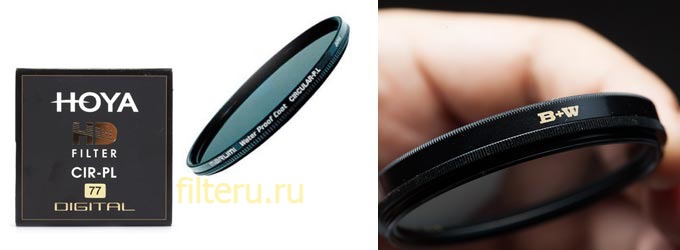
But among the most best polarizing filters experts highlight the following:
- Marumi DHG Super CPL. It has an ultra-thin frame, so it can be used even for 16mm lenses. It gets dirty quickly and is sometimes difficult to clean, but it confidently solves its problems. Production is located in Japan. It is worth noting that Japanese companies are confidently squeezing out German manufacturers, who not so long ago were the undisputed leaders.
- Carl Zeiss T POL Filter. They are distinguished by thin frames, low weight, and lightweight construction. The cost is quite high, but it is justified by the excellent quality.
- Hoya Super HMC. The main disadvantage is the lack of thread, which makes it impossible to simultaneous use with other types of filters.
- B+W KSM Nano. The manufacturer uses an additional eighth layer without disturbing the color balance and light transmission. They are also equipped with a hydrophobic coating, which ensures that drops of moisture roll into balls and remove them from the glass. The brass frame reduces the risk of the device sticking to the lens.
Thus, if you are not a professional, you can opt for models in the mid-price category, which at an affordable price will provide the maximum high quality Images.
And yes, they certainly have some disadvantages, but they are a little different from the benefits they offer. Optical filters are a very versatile tool that allows us to achieve certain effects in photographs. In the case of landscape, our the main task- this is usually the change in light and the different scenarios that we usually encounter, so the filters that serve to control the importance of light.
It is common practice in stores that when someone is looking to buy a camera, they will try to sell a protective filter. However, they continue to offer protection for our lenses from impact and dirt. This is always an opportunity to take into account, no one wants to jeopardize a goal that in many cases is a large economic investment. Nowadays, lenses have greatly improved their technology, and most crystals carry treatments that give them greater stability.
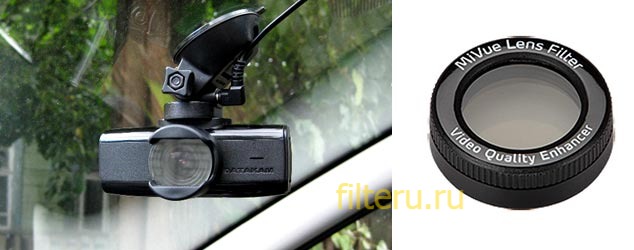
Companies producing DVRs are trying to attract the attention of buyers with various innovations - GPS and Wi-Fi module, G-sensor, and not so long ago the equipment was also equipped with polarizing filters. They are usually installed separately and are not included in the kit. Attached with a magnet or threaded connection.
How general advice for any type of filter comments, every time we put something in front of our target, no matter how good they are, there will always be a reduction in the final quality of our photo. That's why we should only use them when we want to get something out of them.
In conditions of great climatic unfavorability, and when we do not have another filter, it may be a good idea to use it. This resource or photographic technique allows us to give a painterly look to our images and is a very interesting creative resource. Although filters are made that produce this type of finish such as a soft filter, the same can be achieved by applying petroleum jelly in front of the lens. To avoid our lens becoming cloudy, a “protective” filter may be the solution.

Designed to eliminate glare and reflections from the windshield. The picture is clearer and more saturated. This is especially critical in bright sunny weather, while on a cloudy day and in the evening the result may be the opposite, so in such a situation it is better to remove the device.
VIDEO
Purchase polarizing filter for Mia DVRs and other brands will improve image quality, which can be critical in the event of an emergency and further viewing of the recording with traffic police officers.
Agree, it will be a shame if the number of the person responsible for the accident turns out to be unreadable due to the glare of the sun or if it is not possible to see other details of what happened on the road.
Polarizing filters can increase color saturation and reduce reflections - and are the only filter that cannot be replicated in post-processing. This is an essential tool that any photographer should have in their bag. However, developing an intuition about how a polarizer can affect a photo often requires extensive experimentation. This article aims to speed up that process by demonstrating how and why polarizing filters can help (and sometimes hurt) in a variety of conditions.
General information
In the example above, a polarizing filter removes hard, direct glare on the surface of the water.
Polarizers are placed in front of the front lens of the lens, and their principle of operation is to filter direct reflections of sunlight at certain angles. This is useful because other light is often more diffuse and rich in color, but it also requires a longer exposure time (since some of the light is thrown back). The filtration angle is controlled by rotating the polarizing filter, and the strength of the effect depends on the position of the camera's line of sight relative to the sun.
Using polarizers: sun position and filter rotation
A polarizing filter is most effective when the camera's line of sight (shown below in red) is perpendicular to the sunlight:
The red discs indicate the directions of maximum filtration efficiency.
Green lines represent the ground/horizon.
A good way to think about this is to direct forefinger in the sun, while holding the large one at right angles to it. Any direction your thumb, as long as you rotate your hand while still pointing at the sun, will be the direction of maximum polarizer effect.
However, just because a filter has the greatest effect in these directions does not necessarily mean that it will have an effect in that direction. to look like as noticeable as possible. Rotating the filter will change the angle (relative to the sun) at which polarization appears maximum. The best way The way to feel a filter work is to rotate it while looking through the camera's viewfinder (or display), but you can also use the following explanation of the specifics of this process.
Note regarding filter rotation angle. In the limit, you can rotate the filter so that the direction of maximum polarization is perpendicular to the sunlight (as shown in the examples above). In this case, the polarization effect will be maximally expressed. If you then turn the filter slightly (say 10-20°), the polarization effect will become less pronounced. As the angle further decreases towards or away from the sun, the polarization effect will become less and less noticeable, and finally, when the filter is rotated a full 90°, it will no longer be noticeable. Subsequent rotation will lead to a new increase in the polarization effect and repeat the cycle.
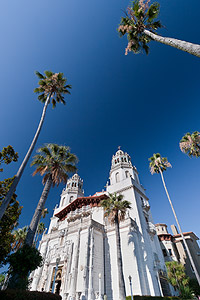
Hurst Castle - San Simeon, California
Because the polarization effect depends on the angle, undesirable results may be obtained when using wide-angle lenses. Part of the image may be towards the sun, and part at right angles to it, in which case the polarization effect will be noticeable on one side of the image, but not on the other.
In the example on the left, the sun was almost at the horizon, causing the strip of sky directly overhead to be most affected by the polarizer (which made it darker), while the upper left and lower right corners (closer to the horizon) were largely unaffected. If a telephoto lens had been used to take the photo (with just one tower in the angle of view), the sky would have looked much smoother.
While wide-angle lenses are obviously not ideal, rotating the polarizing filter can sometimes make the effect more realistic. One way is to place the most pronounced polarization effect closer to the edge or corner of the image. In this case, the change in polarization will appear as a more natural gradient in the sky (such as occurs at dusk).
Color saturation
One of the first characteristics you'll probably notice about polarizers is how much they increase color saturation:
Columbia River Estuary State Park - Oregon, USA
When direct reflected light is filtered, the amount of diffuse light from the subject increases - resulting in a more colorful image. The green of the foliage will become brighter, the blue of the sky will become brighter, and the flowers will also become brighter.
However, color saturation does not always increase equally. All this depends on the optimal angle to the direction of the sun, as well as on the reflective ability of the object. In general, objects that reflect light more strongly will benefit more in color when using a polarizer. In addition, on a clear sunny day, the influence of polarizers is much more noticeable than on cloudy or rainy weather.
In the example on the right, the effect on the stone and foliage is barely noticeable, but the sky becomes noticeably darker. Take care not to exaggerate this effect; Typically dark midday skies or incredibly bright foliage can make photos look unrealistic.
Reflections, windows and transparency
A polarizing filter can be an extremely powerful tool for removing reflections and highlighting objects that are wet, underwater, or behind glass. In the following example, a polarizer allows the photographer to choose between reflections in the water and objects below the surface:
Note that the polarizer was not able to completely remove reflections (although it did a very good job). This is impossible to achieve in principle, but fortunately polarizers can make reflections that would otherwise be quite intense almost invisible. Unfortunately, the exception to the rule is metal surfaces, which also often create the brightest and least acceptable reflections.
A polarizer can also remove unwanted reflections when shooting through a window or other transparent barrier. Hover over the example on the left to see how the polarizer removes reflections in the window. This can be very useful when shooting from a store window, a moving train, or an object in a glass case, for example.
However, polarizers can also create an unnatural streak or ripple effect on uneven, painted or coated windows. A good example on the topic is the so-called “birefraction”, which appears when shooting with a polarizer from an airplane window:
Contrast and shine
Since polarizers suppress direct reflections, this often means a loss of image contrast as well. This can make it easier to shoot scenes with high dynamic range, such as when trying to balance a bright sky with a relatively dim ground (so a gradient ND filter or high dynamic range may not even be necessary).
However, reducing gloss and contrast is not always desirable. In the following example, the artistic intent was to (figuratively) highlight a curved road to make it stand out in contrast to the background. Using a polarizer actually prevented the goal from being achieved:
entrance to Canyon Island national park Sky - Utah, USA
On the other hand, in most situations, removing shine is desirable and usually creates a more pleasing photo. In this same example, the light on the rocks in the distance to the right doesn't look as hard.
In other situations, polarizers, on the contrary, can increase contrast. In the following example, a polarizer increased contrast by filtering out light reflected in haze and sea fumes. This effect looks most pronounced on the hills and cumulus clouds immediately behind them:
In general, using a polarizer on clouds and skies will almost always increase contrast, but if the subject is itself highly reflective, a polarizer will almost certainly reduce its contrast.
Flaws
While polarizing filters are obviously very useful, they do have their drawbacks:
- Because of them, the exposure may require 2-3 stops (4-8 times) more light than usual.
- These are some of the most expensive filters.
- They require a certain angle relative to the sun to achieve maximum effect.
- They can increase the composition selection time because they require rotation.
- They can be difficult to navigate through the camera's viewfinder.
- They can potentially reduce image quality (if the filter is not perfectly clean).
- They generally cannot be used for panoramic or wide-angle shots.
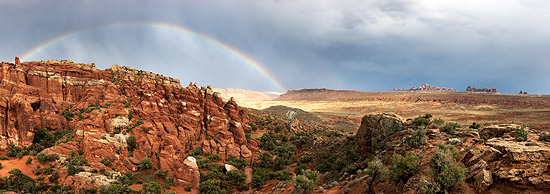
This panorama with a polarizer would look uneven, and the rainbow might simply disappear in some positions. Photo taken in Arches National Park, Utah.
Moreover, sometimes reflections in a photograph are needed. The two most prominent examples are sunsets and rainbows*; If you apply a polarizer to any of them, the color reflections may fade or disappear altogether.
*Note: Polarizers can sometimes enhance the color and contrast of a rainbow by shading background clouds, but only when rotated at the right angle. Additionally, full coverage of a rainbow typically requires a wide-angle lens, which can result in an uneven image of the entire scene or rainbow.
- Replacing the ND filter. A polarizing filter can sometimes be used when longer exposure times are needed. Since a polarizer can reduce the light transmitted by 2-3 stops (4-8 times), this is often sufficient for water/waterfall shots.
- Assessment using polarized glasses. Untinted polarized glasses can help assess how a photo will look. Just be sure to take them off before looking through your camera's viewfinder, as the double effect may prevent you from seeing anything.
- Thin filters on wide-angle lenses. A polarizer can sometimes create a noticeable darkening of the edges of the image (“vignetting”) when attached to a wide-angle lens. To avoid this, you will probably have to spend money on a more expensive “thin” option.
- Circular and linear polarizers. Circular polarizers were designed to ensure that the camera's metering and autofocus systems continue to function while the filter is in place. Linear polarizers are much cheaper, but cannot be used with most DSLR cameras (because they use TTL - through-the-lens metering - and phase detection autofocus).
The article also talks about this and other types of filters:
- Choice of filters: polarizing, protective, neutral and gradient.
This review article about the different filters available to photographers.




